Courage is like love; it must have hope for nourishment. - Napoleon
“The emperor's favorite dish was this kind of chicken fricassee, to which the victor of Italy gave the name "poulet à la Marengo”. The emperor, of course, being Napoleon Bonaparte; the statement from one Constant Wairy, and he should know best about Napoleon’s most intimate habits, likes and dislikes, being, as he was, the emperor’s premier valet de chambre or personal valet, in his service since 1800, elevated to the post of Napoleon’s closest manservant and attendant in 1806. Which he remained until 1814, when, at his boss’s first abdication, Wairy surreptitiously abandoned service, sneaking off with money and jewels, and retired to his country house. In 1830, Constant Wairy published Mémoires de Constant, premier valet de chambre de l'empereur, sur la vie privée de Napoléon, sa famille et sa cour (Memoirs by Constant, the emperor's first valet de chambre, on the private life of Napoleon, his family and his court), again, in a way, stealing from his former boss.
Poulet (chicken) à la Marengo, like coq au vin, Navarin d’agneau (lamb), and beef Wellington, is one of those recipes forever linked to an historic war victory. Poulet à la Marengo, if the legend is to be believed (and I most definitely, lack of evidence to the contrary, want to believe it), was born on the battlefield outside the Italian town of Marengo in the Piedmont on the evening of First Consul and future Emperor Napoleon’s decisive victory over the Austrian Imperial Army of the Holy Roman Empire. On the evening of June 14,1800, chef François Claude Guignet (known as Dunant or Dunand), former apprentice chef in the House of Condé, one of Napoleon Bonaparte's entourage of cooks, created what was to become Napoleon’s favorite - and fetish - dish. And henceforth, one of France’s quintessential, traditional dishes firmly embedded in the nation’s culinary traditions.
But why try to recount the invention of poulet à la Marengo myself when I can turn to Joseph Favre’s Dictionnaire Universel de Cuisine Pratique and transmit his telling of the memorable event. While written almost a hundred years after the battle of Marengo, in 1895, Favre claims “these never-before-seen details were communicated by Dunand himself to my great-cousin A. Bouvier, steward to Valais, who accompanied Napoleon during his passage through Mont-Saint-Bernard, upon his return to Switzerland. This rustic meal had so impressed Dunand that, several years later, he couldn’t resist returning to visit the spot where they had set up camp. ‘So many memories, a world of changes’.”
Who’s to dispute that?
“After a turbulent and eventful battle,” Favre writes, “Bonaparte found himself far from the supply vehicles. On the days of battle, the Emperor ate only after plans and decisions had been made; by this time - having sent the Austrians running - he was famished (his appetite was imperious!) and, dismounting from his horse, demanded to be immediately satisfied. Dunand, his chef, finding himself far from both the closest city, Marengo, and the supply vehicles, sent all of his team running to scavenge whatever ingredients they could find. Together, his men found 3 eggs, 4 tomatoes, 6 crayfish, and a chicken. Feeling as if these odd and meager ingredients would never make a dinner worthy of Napoleon and his 2 accompanying officers, he did, nonetheless, improvise and create a meal. First he created a broth of water, garlic, and salt. He cleaned the bird and cut it into pieces and, having neither butter nor onions, proceeded to fry the pieces in oil with a few cloves of garlic. He fried the eggs, as well, removing them from the oil and setting them aside. After draining the grease from the pan, he added water to the chicken, added the tomatoes, seeded and chopped. He placed the crayfish on the chicken, steaming them, then set them aside. Not having wine to flavor the sauce, he added cognac from Napoleon’s flask, arranged the chicken on a platter, poured the sauce over the bird, and garnished it with the crayfish and the fried eggs. Napoleon, satisfied and happy, exclaimed to his chef “You'll serve it to me like this after every battle”. Dunand eventually perfected the dish, adding white wine and mushrooms, and eliminating the crayfish which he didn’t believe went well with the rest. Receiving the recreated version of his now favorite dish, Napoleon, furious, shook the plate and banged on the table, calling Dunand: “You removed the crayfish from the poulet à la Marengo! That will bring me bad luck! I don’t want it anymore!” And this is why, according to Favre, “one continues to serve poulet à la Marengo garnished with crayfish even though they don’t go well with the dish.”
Marengo chickens sing like a song of victory. - Jean Camille Fulbert-Dumonteil, forward to the Dictionnaire Universel de Cuisine Pratique

Poulet à la Marengo - or Marengo-style chicken - is a traditional French recipe based on pieces of chicken browned in oil and then simmered in a tomato, mushroom, white wine, and cognac or Madeira sauce. Favre’s own method for making this dish (actually, as he notes, this is how it was made at Chevet during Napoleon’s reign, referring to Maison Chevet in the Palais-Royal where Favre himself, among other celebrity chefs, once worked, possibly as director): sauté chicken pieces in oil with garlic; drain the oil and add half a bottle of Sauternes to the chicken; add a very reduced tomato purée, a clove of garlic, salt, and a point of Cayenne pepper along with a bit of water, if necessary. Add the liquid (juice) from 250 grams of mushrooms cooked in butter, salt, and the juice of 1 lemon. Once the chicken is cooked, arrange the pieces in a shallow serving bowl, add the mushrooms to the sauce with a small glass of old Madeira, and finish the sauce with a bit of butter. Pour the sauce over the chicken and garnish with 3 fried eggs sliced into quarters and 3 boiled crayfish.
What actually astonishes me in all of this is just how quickly poulet à la Marengo went from the battlefield to being a fixture in Paris’s best restaurants.
The 1814 Le Guide des Dineurs ou statistique des principaux restaurans (sic) de Paris - indispensable for foreigners, necessary for people who don't keep house (who don’t maintain an establishment of their own), useful for all people of taste - lists quite a number of Parisian eateries who serve not only chicken (poulet) Marengo - as well as a variation with truffles - but the same made with young hare or rabbit (lapereau), as well, most famously Les Frères Provençaux; some believe it possible that this high-end dining establishment, popular in Paris since its opening in 1785, was the first to serve this soon-to-be iconic dish, just as they are thought to be the first restaurant to introduce the tomato to the capital city. Menus available for several restaurants in 1828 also list both chicken and partridge Marengo style, with or without the addition of truffles.
A year after the publication of Le Guide des Dineurs, in 1815, Marie-Antoine (Antonin) Carême mentions Le fritot de poulet à la Marengo, sauce tomate, garni d’œufs frits (fried chicken pieces Marengo style with tomato sauce, garnished with fried eggs) in Le Pâtissier Royal Parisien, listed as a suggested dish in the category “poultry or game” though he offers no recipe. In 1822, Carême suggests the same dish - now spelled Maringo - as an element of several dinner menus in his book Le Maître-d'hôtel français, ou Parallèle de la cuisine ancienne et moderne. While André Viard didn’t mention Marengo in either his 1806 or his 1817 editions of Le Cuisinier Royal, he makes up for it in his 1822 (11th) edition with recipes for calf sweetbreads (ris de veau) and young hare or rabbit (lapereau) à la Marengo. In1844, he includes Marengo rabbit (lapin), hen (poularde), and sweetbreads (ris de veau), and his1853 book Cuisinier National includes hen (poularde) and rabbit (lapin) with his other Marengo recipes, as well.
Just 35 years after this memorable dish was created on a battlefield with an unlikely hodgepodge of ingredients rummaged from war-torn who-knows-where in the Italian countryside, Marengo has not only embedded itself into the national repertory of cuisine, but has taken off. And chefs never looked back.
Antoine Beauvilliers, chef-owner of the first prominent fine restaurant in Paris, seemed to truly differentiate and refine the different recipes for Marengo in his 1835 book Le Nouveau Cuisinier Royal: Lapereau à la Marengo (cut the hare into pieces, cook in oil, salt, pepper, nutmeg, garlic and bay; remove from the pot when cooked, add truffles, mushrooms, “un peu d’essence de gibier” (a little game stock), and tomato sauce; boil, add lemon juice, serve); Ris de veau à la Marengo (cook in olive oil with salt, pepper, nutmeg; drain off the oil and replace with a few spoonfuls of sauce éspagnole (a reduced meat stock) in which truffles, mushrooms, parsley and garlic, glace de viande (meat glaze), and tomato sauce have been added); Poularde à la Marengo (garlic, parsley, mushrooms, a spoon of tomato sauce and 2 spoons of reduced éspagnole, truffles and lemon juice to serve); Poulet à la Marengo (mushrooms, sauce italienne to which one adds the oil the chicken was fried in; one can garnish with fried eggs or croutons and clarified butter).
Beauvilliers’ cookbook was followed quickly a year later by Dictionnaire de Cuisine (and household economy) by M. Burnet with a similar selection of Marengo recipes, each meat deserving of its own slightly adapted variation: Lapereau à la Marengo (pieces cooked with salt, pepper, nutmeg, garlic, and bay; the meat is removed from the pan to which mushrooms, truffles, game stock, tomato sauce, lemon juice are added); Ris de veau à la Marengo (the sweetbreads are sliced, cooked in olive oil with salt, pepper, nutmeg; the oil is drained off and replaced with stock, truffles and mushrooms, parsley, garlic, tomato sauce, and meat glaze); Poulet à la Marengo (chicken pieces are cooked in oil with a bouquet garni, then mushrooms and truffles are added; the chicken is plated when cooked; a sauce Italienne, thinned with a bit of the oil the chicken was cooked in is added to the pan; the sauce is then poured over the chicken which is then dressed with fried eggs, croutons, and clarified butter); and finally Poularde à la Marengo (the method for hen follows that of chicken but it’s simpler, making a sauce using only truffles, tomato sauce, stock, a little lemon juice).
And then in 1837, Antoine Claude Pasquin, writing under the name Valéry, throws water on the fire by actually questioning the origins of the dish. “As for the chicken à la Marengo,” he writes in his personal tourist guide L’Italie Confortable, “improvised after the battle for the First Consul, with oil, because butter was lacking, with mushrooms, morels, white wine, and crusts that were found there, if it is of Piedmontese origin, the victory naturalized it as French.” While the recipe could have had many points in common with a dish Valéry called "poulet à la piémontaise” or some similar dish long known in that region (and evidently to Valéry), it could simply be due to the fact that Dunand was only able to gather together ingredients that were common to the region - chicken, olive oil, truffles, and tomatoes - in order to cook for Napoleon.
And yet, Favre’s story of the invention of poulet à la Marengo wasn’t the first published. Relation Complète de la Guerre d’Italie depuis le départ des troupes jusqu’à leur rentrée triomphale le 14 août 1859 (The Complete Story of the Italian War from the departure of the troops to their triumphant return), a book of the collection of the popular magazine Journal de la Guerre (Bulletin de l’Armée - Correspondance du Camp - Description des Batailles), compiled and published in1859 (price 1 franc 75 cents) has a short paragraph in which Édouard Fournier, author and historian, recounts his own tale of the origins of the dish, a story originally published in the June 14,1859 issue of The War Journal, 59 years after the famous dinner itself.
“The evening of the battle of this name, the first consul had a victor’s hunger. ‘Hurry, a chicken for the hero! If it’s fat, all the better; if it’s tender, better still!’ The wished-for chicken was found, and nearly beyond reproach; but butter was needed, and unfortunately, despite a thousand inquiries across the entire countryside, the only butter to be found was the size of a hazelnut. Oil, on the other hand, was in abundance. The consular cook filled the bottom of the pot, placed the chicken atop this unctuous layer, flavored the oil with garlic, dusted it with a light touch of pepper, added a splash of white wine, the best the country had to offer; surrounded the dish with croutons, mushrooms and morels, in lieu of truffles, and served it hot. It was, on this day of victory, one more conquest. The hero applauded with all his appetite (with all of his might), and since this day, the poulet à la Marengo always appears on the best-served tables.”
Whatever the origin of this now common dish, the name Marengo has definitively moved into the lexicon of French cuisine with a clear meaning and an understood set of ingredients: À la Marengo enters the Nouveau Dictionnaire Universel de la langue Française by Prosper Poitevin in 1860 as its own culinary term: manière d’accommoder la volaille, en dépeçant, la faisant saisir par un feu ardent et achevant de la cuire avec des champignons et de l’huile d’olive: “a way of preparing poultry by butchering it, searing it over a hot fire, and completing the cooking with mushrooms and olive oil”.
Our old friend Urbain Dubois slowly helps to both define and refine the recipes, from his 1868 poulet sauté à la Marengo in La Cuisine Classique (chicken pieces and filets are sautéd in ½ butter and ½ oil with salt, parsley, bay leaf, garlic; the butter is drained from the pan, the chicken drizzled with meat glaze and Madeira and cooked until the sauce is reduced and the chicken glazed; the chicken is plated and covered with a sauce Napolitaine made with mushroom trimmings, cured ham, onion, herbs, Marsala, tomato sauce, stock then cooked to thicken; the dish is garnished with lemon juice, chopped parsley, sliced fried eggs, and cooked mushroom caps) to poulet sauté à la Marengo (light tomato sauce and 2 stocks), lapereau sauté à la Marengo (white wine, tomato sauce, 2 stocks), and finally introducing cooks, possibly for the first time, to veau à la Marengo (bouquet garni, petit-salé (ham), 2 or 3 dozens small onions, tomato sauce, and either cayenne pepper or espelette and bouillon in which 1 kilo of veal has been cooked) in his 1888 edition (9th) of Nouvelle cuisine bourgeoise pour la ville et pour la campagne.
And as foods go in and out of fashion, so do recipes… by the beginning of the 20th century, sweetbreads, rabbit, and hen are no longer à la Marengo, and most every cookbook now seems to offer both chicken (poulet) and veal (veau, almost always tendron de veau - bone-in veal breast - sometimes mixed with veal shoulder) prepared in this fashion, with slight variations in the 2 recipes as each is adapted to the meat being cooked. And cookbook authors are now finally bringing these dishes to the home cook. Jean Anthelme Brillat-Savarin, Gustave Geffroy, and André Theuriet (consolidated and with notes by Edmond Richardson) offer a whopping 1600 recipes in their 1906 L’Art du Bien Manger (The Art of Good Eating) curated with “practical formulas for preparing famous dishes from top restaurants and master chefs at home” including a recipe for both: Poulet à la Marengo (chicken pieces are cooked in oil, salt, pepper, quatre épices, bouquet garni, a handful of mushrooms; flour is added to make a roux blanc, consommé then a glass of good Madeira and a little white wine are added along with a little of the oil the chicken was cooked in; the chicken pieces are arranged on the serving platter, the sauce is poured over the chicken then garnished with the cooked mushrooms, slices of truffle, and a few crayfish) and Veau à la Marengo (veal chunks are sautéed in oil and butter, chopped onion, garlic, bouquet garni; white wine, and, when reduced, broth or stock are added; this is simmered until cooked through, the bouquet garni and garlic are removed, a pinch of Cayenne and a few spoons of tomato sauce complete the sauce.)
Poulet and veau à la Marengo have now become standards of la cuisine bourgeoise, more a classic dish of the upper middle class rather than homey peasant fare, possibly due to its illustrious roots on Napoleon’s dining table, no matter how rustic that dining table’s surroundings were. And yet the origins of this now-famous recipe are still being disputed.
Austin de Croze claims in his 1928 book Les Plats Régionaux de France that “Dunan (sic) created the ‘poulet Marengo’ and Maneille perfected it.” Maneille being the chef at “the famous restaurant of the Trois Frères Provençaux which flourished in Paris in the days of the First Empire.” De Croze opens his recipe for le veau Marengo with “Created, it is claimed, on the battlefield by Napoleon's cook, (Napoleon being) the very opposite of a gourmet, this dish is a favorite among Parisians and even the most popular among them.” Elizabeth David added her thoughts in French Provincial Cooking in 1999 that Maneille actually created the dish for Napoleon’s generals upon their victorious return from Italy.
From its heyday in Paris’ fine dining establishments and as the recipe found its way into cookbooks and thus into homes, chicken à la Marengo - and now its veal counterpart - will still and always be forever connected to Napoleon’s great battle victory, adding a special flare and intrigue to both dishes. As Alexandre Dumas wrote in 1873 in his Grande Dictionnaire de Cuisine:
“Napoleon wasn't a gourmand, but he wanted every great official of the Empire to be. "Keep a good table," he used to say, "spend more than your salary; run up debts, I'll pay them." Far from having enriched the gastronomic repertoire, all of his victories are indebted to just one dish: chicken à la Marengo.”
I have decided to recreate veal à la Marengo rather than the original dish made with chicken. I love the long simmering of the dish, making for a richer, more flavourful sauce (sauce, not gravy). It does take a bit of prep time to organize all of the ingredients and prepare them all for cooking, followed by the browning time for both meat and vegetables, but it is so worth it. The white wine gives a slight but very nice acidic tang to the sauce, but you can always add a bit less (use at least ½ a cup) and replace it with one extra peeled, seeded, chopped tomato, if you like, to change the balance of flavors. Also, feel free to increase your quantities of mushrooms and pearl onions. And, like many of the early chefs did, add a nice pinch of Cayenne pepper in with the mix.
Veau à la Marengo
2 to 2 ½ pounds (1 kilo) veal bone-in breast and/or shoulder cut into largish 2-inch chunks (* see note below)
Olive oil
Butter
Salt and freshly ground black pepper
7 to 8 ounces (200 to 240 grams) mushrooms (champignons de Paris), trimmed and coarsely chopped (* see note below)
12 to 15 pearl onions, trimmed and peeled (if using larger new onions, slice each in half)
2 tablespoons flour
1 cup dry white wine
2 or 3 tablespoons cognac or Madeira, as desired, optional
1 cup veal or beef stock
2 medium-large tomatoes peeled, seeded (if the seeds are large), and chopped
3 purple shallots, peeled and sliced fairly thickly
2 cloves garlic, peeled and sliced
1 bouquet garni; can be replaced with ½ teaspoon chopped fresh thyme leaves or large pinch dried thyme and 2 bay leaves
Chopped fresh parsley, preferably flat leaf parsley
2 or 3 tablespoons of tomato purée or canned chopped tomatoes - not paste - optional
Croutons made from stale baguette or pain de campagne (country loaf) and butter, for garnish, optional
* note : if you prefer, you can simply halve smaller mushrooms and quarter larger mushrooms instead of coarsely chopping them. Also, my butcher was out of tendrons or bone-in breast so I used a mix of veal shoulder (veal for blanquette) and shank (veal for osso buco) as I wanted some bone for the flavor and to help thicken the sauce.
Pat the veal chunks dry with paper towels then lightly salt and pepper on all sides.
Heat 2 or 3 tablespoons olive oil and 2 or 3 tablespoons butter in a large, heavy Dutch oven or pot over medium-high heat until it begins to sizzle or smoke. Add just enough of the veal chunks to make a single layer without crowding; brown the chunks of meat on all sides, turning as needed. (If they color but don’t brown immediately, just let them go longer as they will brown.) As the meat browns, remove to a plate and set aside. Add the rest of the meat in a single layer, adding just enough oil and butter to the pot if and as needed (I did not have to); brown the rest of the veal and remove to the plate and set aside.
Add the mushrooms to the fat in the pot and cook, stirring constantly, to quickly cook; cook off any juices or water the mushrooms release. Once cooked, remove the mushrooms to a clean bowl or plate using a slotted spoon and set aside.
Now add the pearl onions to the pan (there may be very little fat left but don’t worry) and cook, stirring constantly, until softened and lightly browned. Remove from the pot and add them to the cooked mushrooms.
Lower the heat and add about 2 tablespoons butter to the pot and quickly deglaze the pot by scraping the bottom with a wooden spoon. Add the veal and any runoff juices back to the pot. Sprinkle the flour over the chunks of veal and stir the meat quickly and constantly, turning the pieces often, for just about 2 minutes or so until all of the flour has been dissolved into the juices, allowing the time to cook.
Add the veal stock and raise the heat again and deglaze the pot again. Add the white wine and the cognac or Madeira. Add the chopped tomatoes, the sliced shallots and garlic, the thyme and bay leaves, and a handful of coarsely chopped parsley. Add the onions, mushrooms and their juices back to the pot. Add a few more grindings of black pepper. Add a pinch of Cayenne, too, if you so please! Now add just enough water, just to cover the meat.
Cover the pot, lower the heat to low (the liquid should just simmer), and cook for 1 hour.
At the end of the hour, uncover the pot and cook, stirring occasionally, scraping the bottom of the pot, for up to another half hour to finish cooking the meat and to thicken the sauce.
(If you like a slightly more tomatoey sauce, add a couple tablespoons of tomato purée to the pot. I did not.)
To serve, top with a bit of chopped parsley and, if desired, croutons or slices of baguette or pain de campagne that have been browned in butter until crispy.
Thank you for subscribing to Life’s a Feast by Jamie Schler where I share my recipes, mostly French traditional recipes, with their amusing origins, history, and anecdotes. I’m so glad that you’re here. You can support my work by sharing the link to my Substack with your friends, family, and your social media followers. If you would like to see my other book projects in the making, read my other essays, and participate in the discussions, please upgrade to a paid subscription.
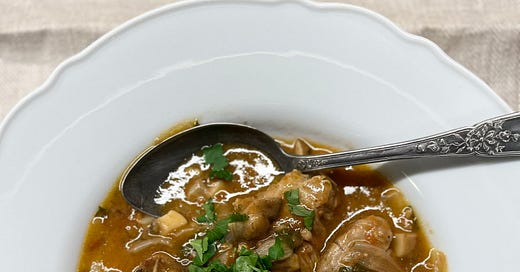



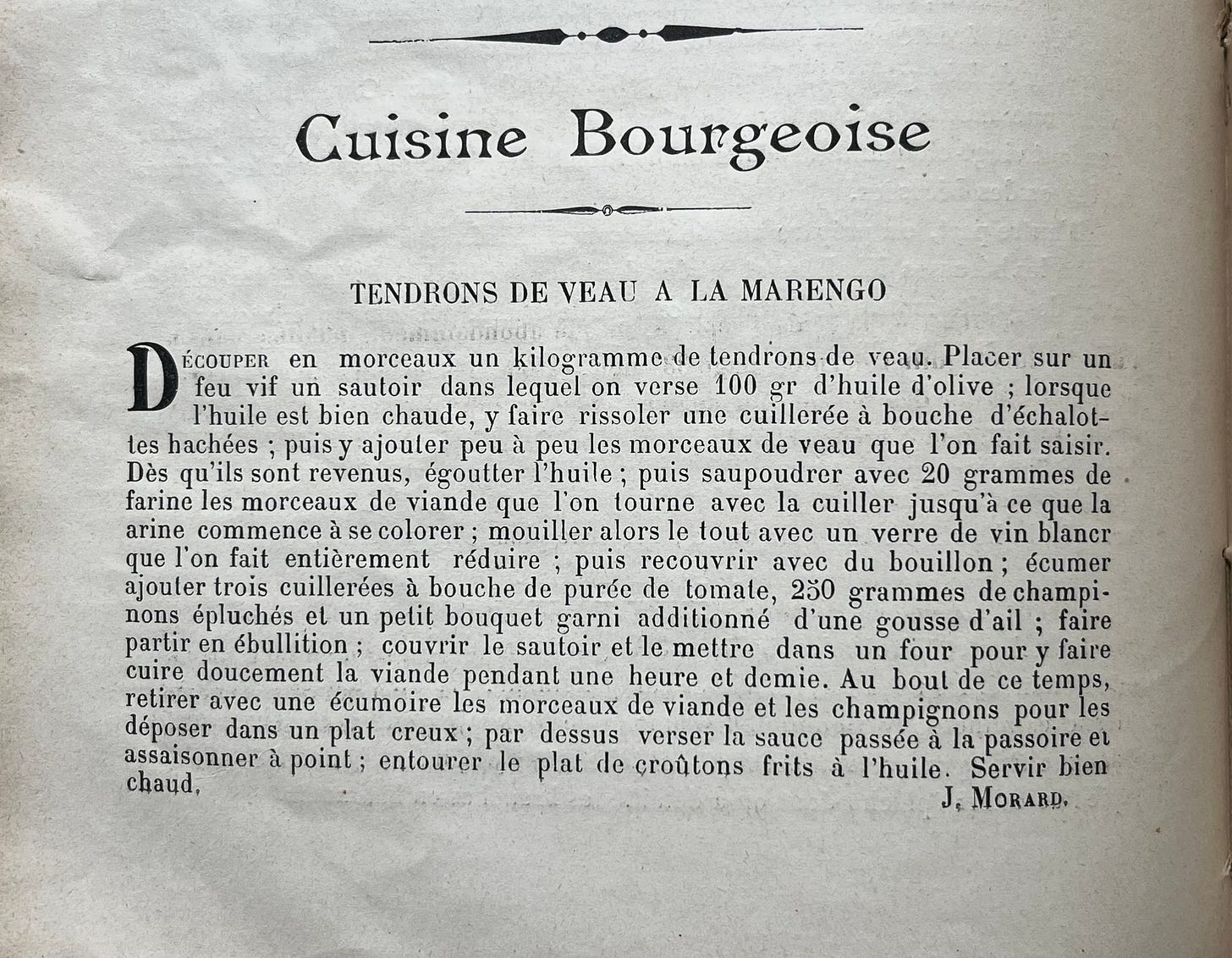
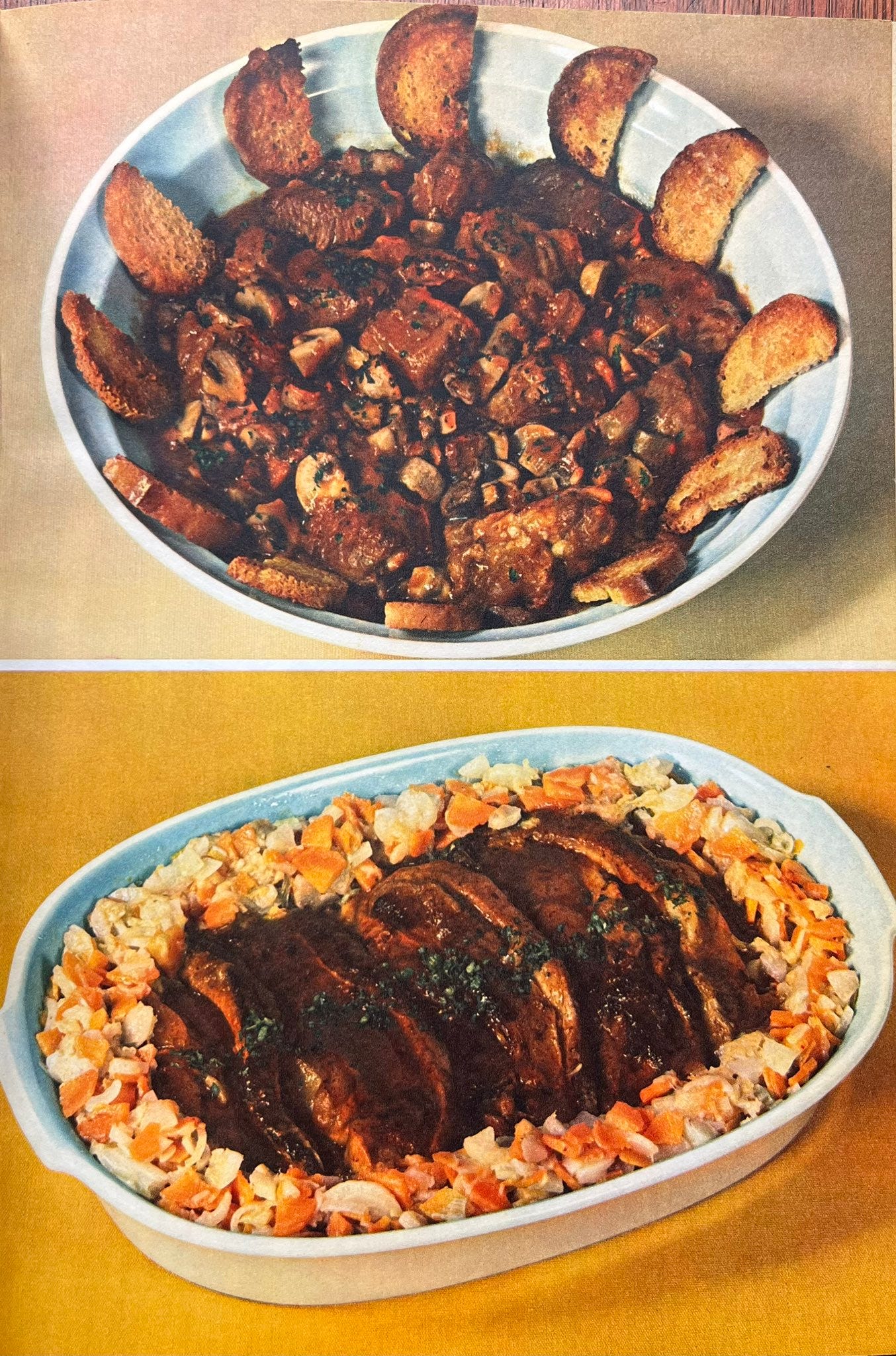
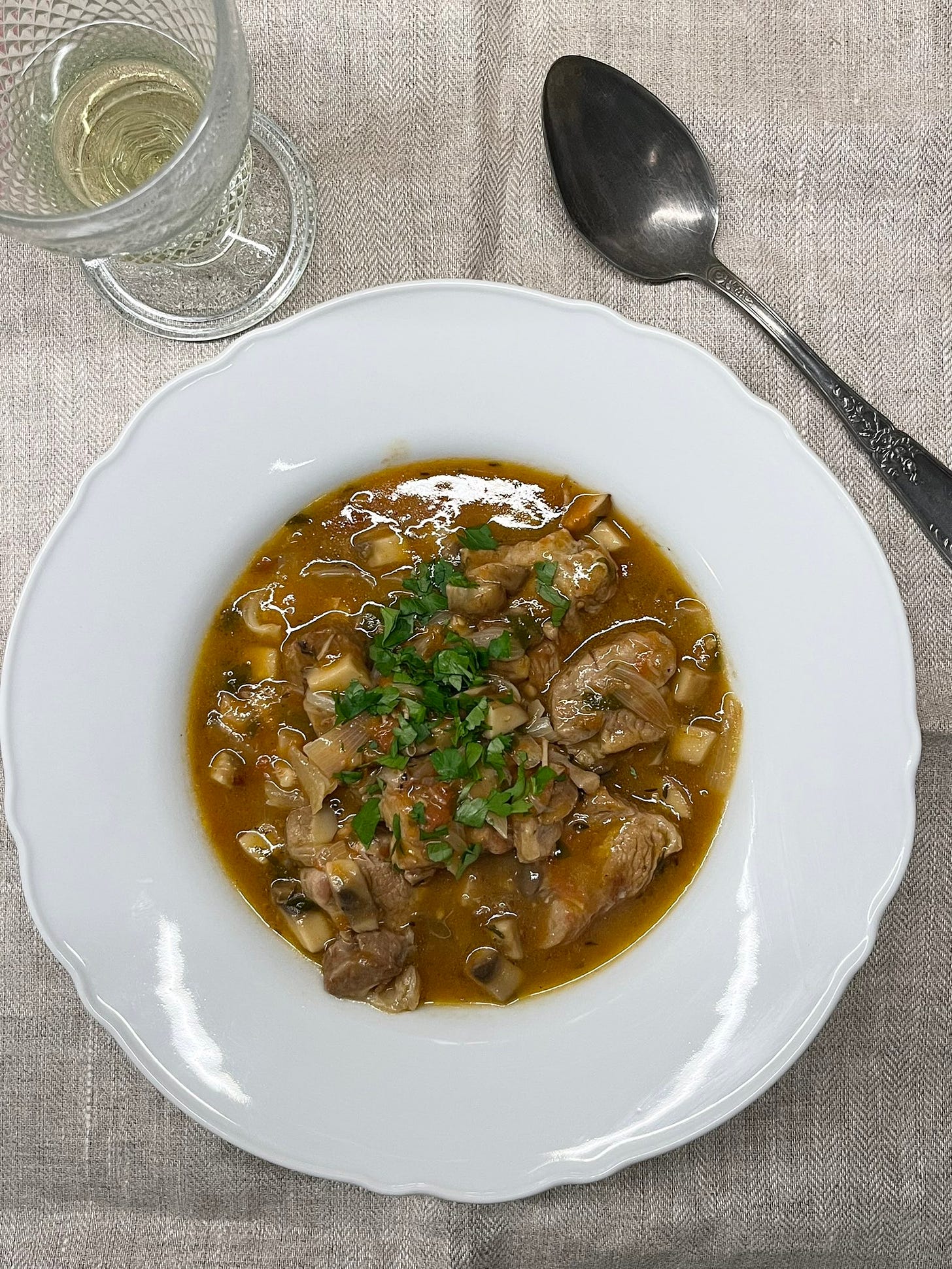
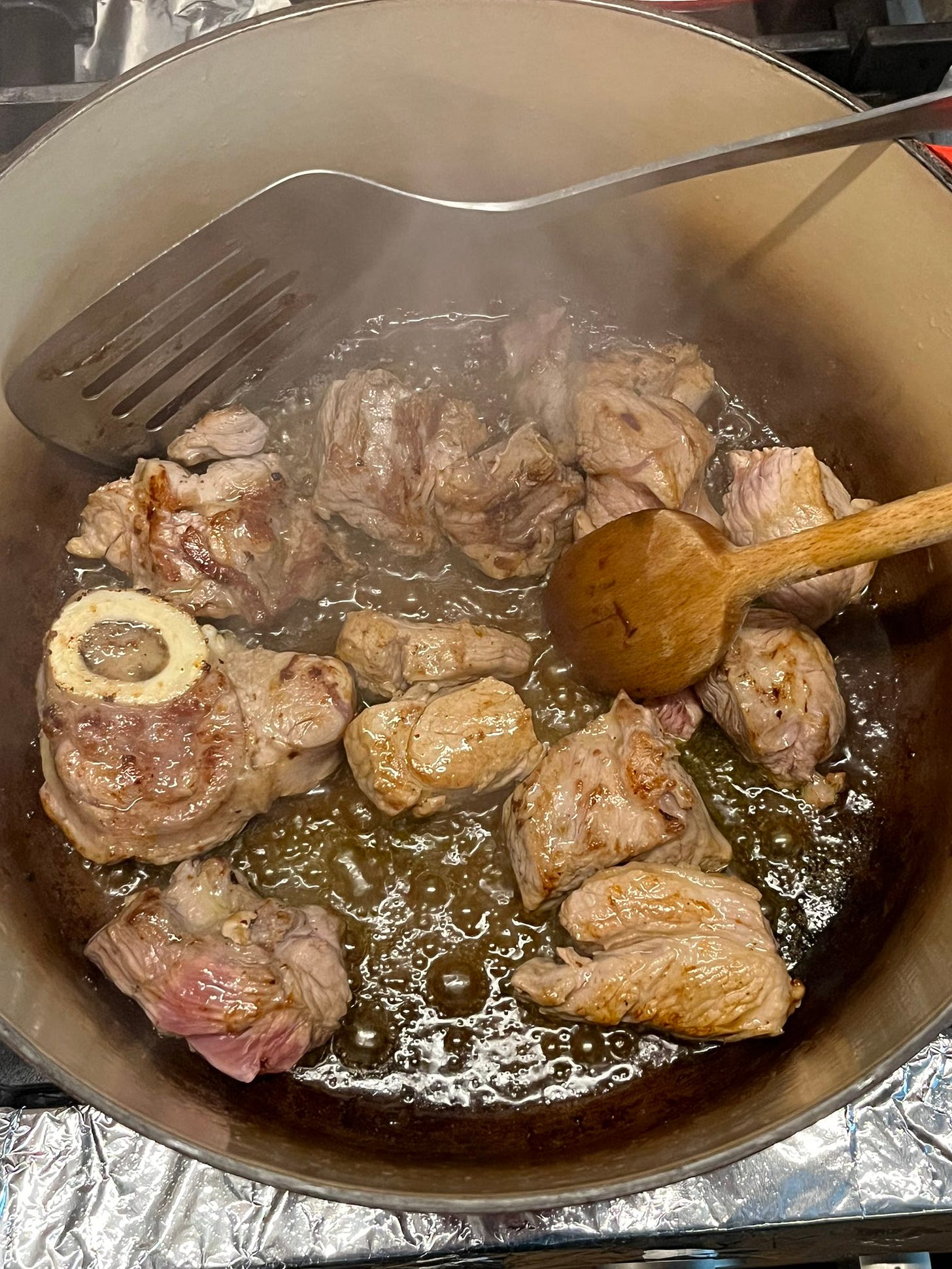
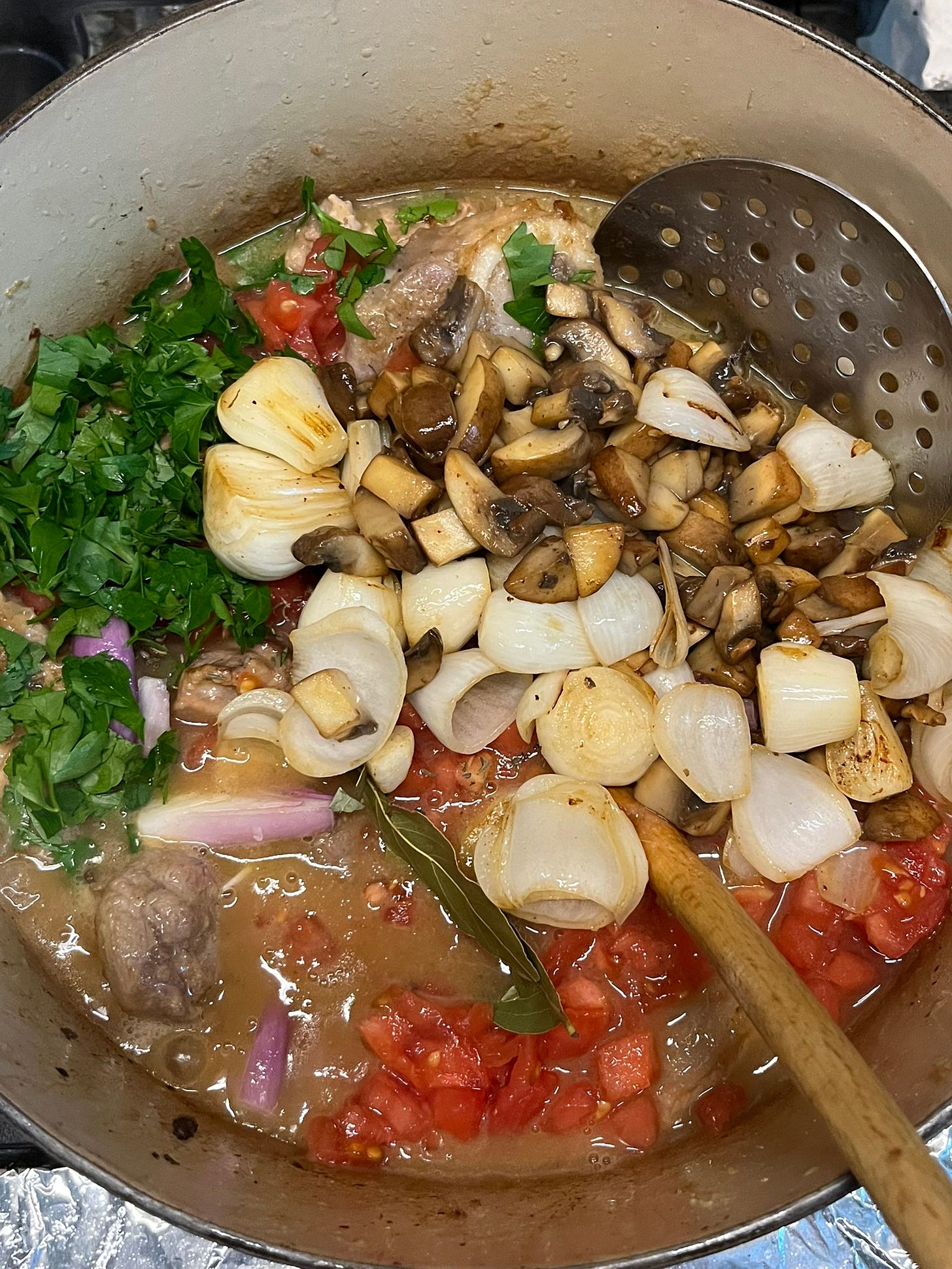

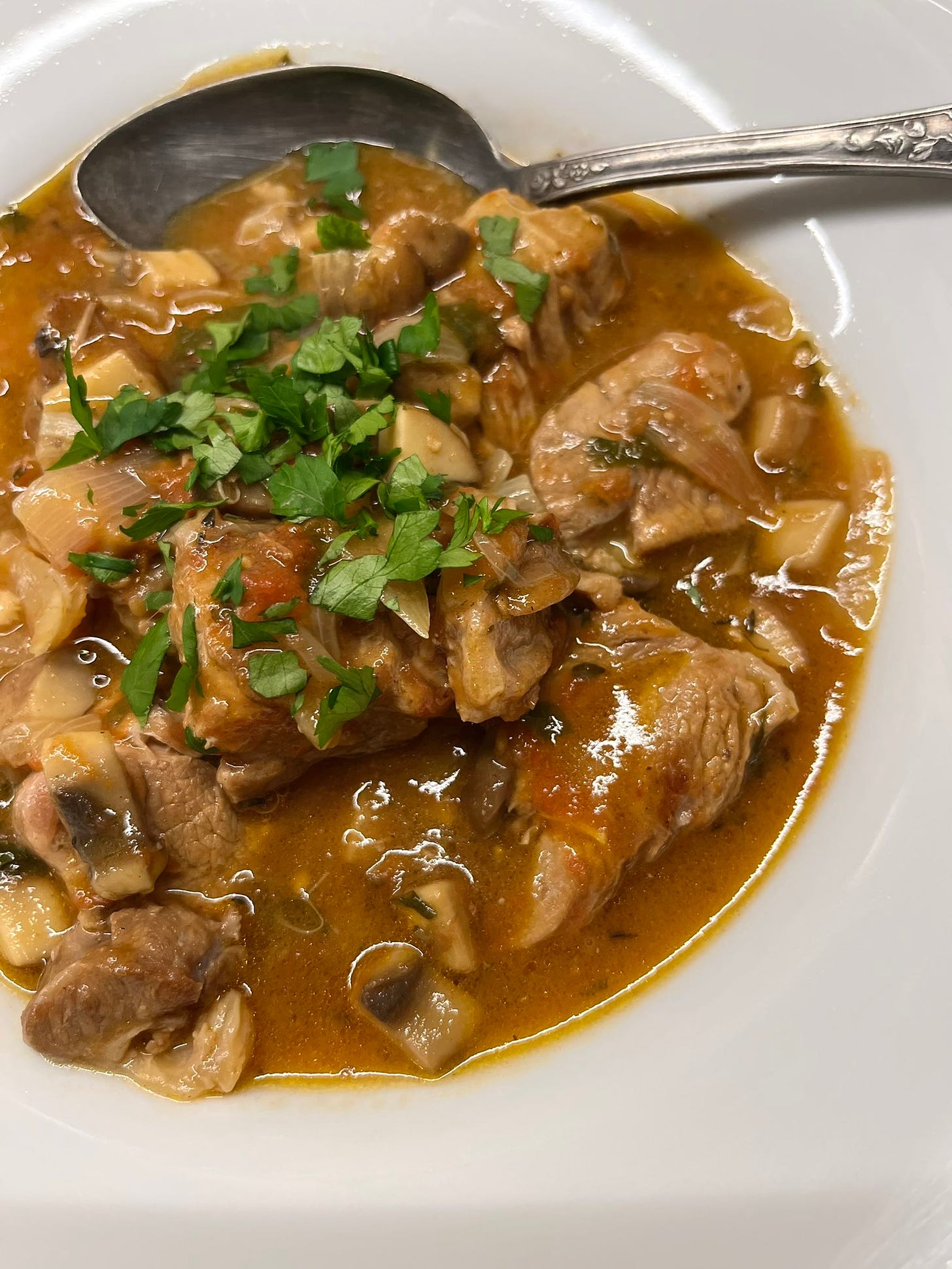
Another dish with a fascinating history. Did not know about its Italian origins. No wonder its so good 😂😂😂
Wow. Never knew the history.
Thank you Jamie!